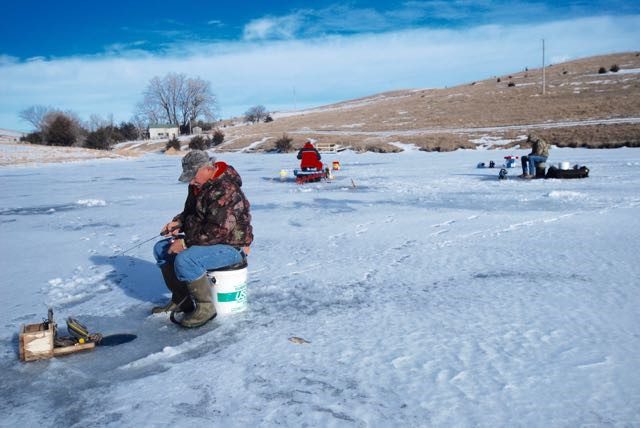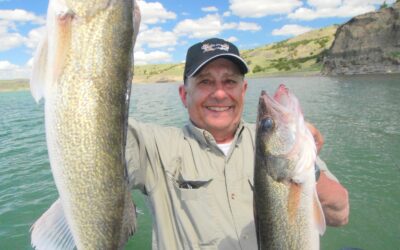Late season ice fishing can be one tough go, as the fish have seen about everything and you’ll have to change and go to finesse baits.
As the winter wears on, ice fishing will begin to slow. There are, however, some things you can do to spark more action.
There’s one thing you can take to the bank if you are an ice fisherman during the month of February. Catching fish is just going to get tougher.
The bloom of early ice is off. Gamefish have settled into the doldrums of winter. If you are going to catch your share, whether it is bluegills, crappies, perch or walleyes, you are going to have to fish smarter.
Generally that means lightening up. Smaller baits, lighter lines, more precise presentation all play a greater role late in the ice fishing season.
If you have been fishing four pound test, you might consider switching to two pound. But even more importantly, you need to fish fresh line. Monofilament has a memory. That memory means the line comes off your spool in curls. Your tiny ice fishing jigs or teardrops are not heavy enough to take out those curls, so you are never in direct contact with your lure.
One thing the use of underwater cameras have shown us is how lightly late winter panfish hit lures. We’ve watched bluegills and perch swim up to a lure, inhale it and spit it out all in one motion.
If you are using a camera, you can probably hook that fish. If not, you won’t even know it inhaled the bait. Sure, you can see the fish on your flasher, but you can’t tell if he has the lure.
One little trick I use is the when I see the fish signal merge with my bait signal I began raising my rod tip feeling for pressure. Quite often, especially this time of year, the fish has taken the bait with no indication even if I’m using a bite indicator.
So here’s the thing. Having coils in your line severely complicates the catching of light biting fish.
I could make a strong argument for changing your line each time you go fishing.
That doesn’t mean you put on an entire 110 yards of new line each time. If you are fishing 30 feet or less, put on 40 feet of new line, using a blood knot to join the old with the new.
Once you are on the ice, it is a good idea to hook your lure on something heavy like your ice shack or snowmobile and stretch the line to remove the memory coils before fishing.
A good argument can be made for using one of the new “super” lines for ice fishing. There will be no coils in the line and no stretch so your sense of feel will be greater. The deeper water you fish, the more important it is to use a super line.
Are there other ice fishing tricks which will help you take late winter fish? You bet.
If you are fishing a vertical bait like a tear drop and you see fish swimming in, but not taking the lure, switch to a horizontal lure like a jig. Sometimes panfish will show a preference for one or the other. Make sure your knot is positioned at the top of the eye of the hook so the bait is truly horizontal.
Another trick is to spin your lure. Fish may be conditioned to seeing that up and down action usually applied to ice fishing lures. Grab the line between your thumb and index finger and spin it. The lure will spin and when you stop doing it, the fish may bite.
I often use the rod tip to go from one side the hole to the other. This moves the lure on a horizontal plane and often triggers a bite.
Flashing is always a good technique. Swiftly raise the rod tip as high as you can, jig the lure in place and let it drop back down. This often calls in nearby fish.
Hammer the bottom with your lure. Bouncing it up and down off the bottom causes little puffs of bottom sediment which also attracts fish.
If your hole has gone dead and you haven’t noted any fish on your flasher for some time, try an attractor. I like to use a big rattle bait or a Salmo Chubby Darter. One of these lures is rigged on another rod carried specifically for this purpose.
Drop the lure down your hole and jig it enthusiastically. If there are fish nearby, this will pull them in.
A longtime fishing friend of mine, the late Jim McDonnell always carried a rod rigged with an ice spearing decoy. More than once I watched him bring fish to his hole using the decoy and then dropping down his presentation.
You can also try putting “attractors” on your ice fishing lures. The Swedish Pimple comes with a little red “flapper,” a piece of plastic attached to the split ring holding the hook. I’ll often tie a short, thin piece off red yard to my hook or above the teardrop or jig using a simple overhand knot.
I think it looks like a bloodworm, an aquatic worm that is plentiful in most of our fishing waters. There is even a fly pattern tied to represent these worms. It’s called the San Juan Worm, and is a very productive pattern, especially in tailwater fisheries.
You should also learn how to tie a loop knot. Many ice fishing lures perform better, spoons especially, when tied with a loop knot.
Bite indicators become even more important late season. Sometimes the only way you can detect a bite is to raise the rod and watch the bite indicator bow down. Fish on.
Fishing the right bait also is important now. In the Siouxland area about the only available bug baits are waxworms. While a big, fat waxworm looks good on the hook to us, it doesn’t look so good to finicky panfish. Hook them in the middle and squeeze out all the juice. This leaves just two flaps of skin which dangle enticingly on the hook.
If you are able to buy maggots, be sure you are applying them correctly to the hook. One end of the maggot is pointy. That is the tail. The other end is flat with two, little brown spots. This is the head. Take the hook and just nick the skin on the head. The maggot will wriggle on the hook for a long time. It’s usually best to hook on several maggots at a time.
Chumming is another trick that can pull fish into your hole. Toss down a few extra waxworms or grubs and let them sink to the bottom. It might start a feeding frenzy.
Fishing at the right time of day can also make a big difference. Generally speaking, that is early and late. My preference is that hour just before sundown. I call it the Happy Hour because I usually catch lots of fish at that time and that makes me happy.
Late season fishing success is all about fishing smarter. Part of that is applying a few “finesse” tricks to your presentations.






0 Comments